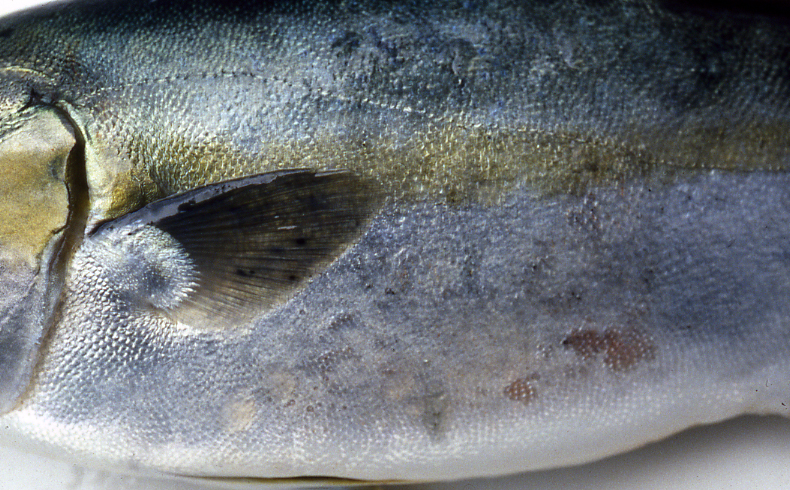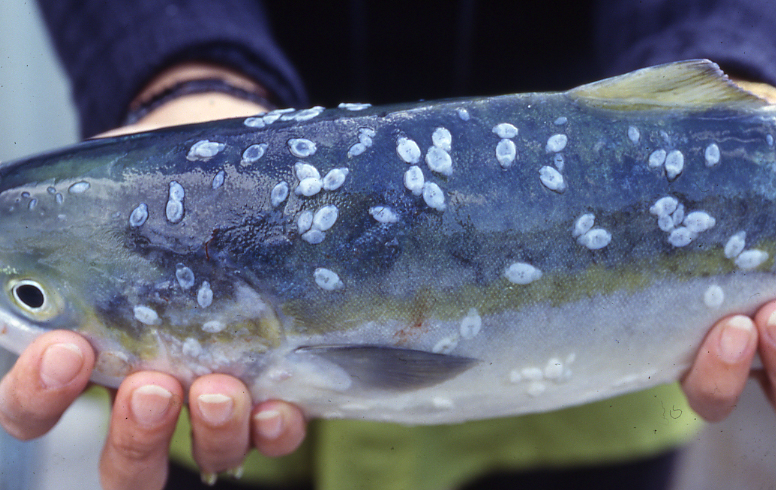

(Photos by K. Ogawa)
| Parasite | Benedenia seriolae (Skin fluke) |
|---|---|
| Taxonomy | Plathyhelminthes, Monogenea, Monopisthocotylea |
| Hosts | Yellowtail (Seriola quinqueradiata), Greater amberjack (Seriola dumerili), Yellowtail amberjack (Seriola lalandi), Almaco jack (Seriola rivoliana) |
| Infection site | Skin |
| Clinical signs | Parasite (max. about 12 mm) is observed on the body surface. The lesion is erosive and the mucus is excessively secreted. Irritation by the parasite causes the affected fish to scratch their body on the net, resulting in skin wounds (Fig. 1). |
| Parasitology | Benedenia seriolae (body length (adult) 5-12 mm) is flat and oval. The parasite attaches to the host by a haptor with 2 pairs of anchors at the posterior end and a pair of suckers at the anterior end (Fig. 2). The hermaphroditic adult produces tetrahedral eggs with filamentous threads (2-4 mm). The eggs hatch on 52.1 days at 12.5 C.; 6.5 days at 21.3 C.; 5.2 days at 23.9 C. (Hoshina and Matsusato, 1967). Egg hatching rate is above 50 % at 12.5-26.9 C; 3 % at 29.7 C; 0 % at 9.4 C. When incubated under laboratory conditions with natural illumination, the eggs hatch throughout the hours of daylight, but in the night hatching was curtailed (Kearn et al., 1992). |
| Pathology | Benedenia seriolae causes the retardation of growth following to the low feeding. The lesion is eroded by attaching of the haptor and wounded by feeding of the parasite. Secondary infection occurs since bacteria invade through the wounding site resulted from the scratching on the net (Ogawa, 2004). |
| Health hazard | Since this parasite is not infectious to human, it is harmless in food hygiene. |
| Diagnosis | The parasite can be identified by morphological observation in a flattened preparation. B. seriolae can be distinguished from Neobenedenia girellae, a monogenean infecting to Seriola spp., by morphology. N. girellae is more elongated and smaller (body length 3-8 mm). Furthermore, the anterior structure between two suckers is concave and convex in N. girellae and in B. seriolae, respectively (Kinami et al., 2005). |
| Other information | This disease has been problematic in a marine net-pen culture since 1960s, when yellowtail culture started, because the eggs with a long filament readily become entangled in a net cage. This disease is one of the most problematic diseases in a yellowtail culture at present. It is recommended to kill the parasites at the body surface by the freshwater-bathing for 5-10 minutes (longer when water temperature is low) and to regularly change the net for removing the entangled eggs. Currently, bath treatments with a hydrogen peroxide solution and oral administration of praziquantel can be used for control of the parasite. |
| References | Kearn, G. C., K. Ogawa
and Y. Maeno (1992): Hatching patterns of the monogenean parasites Benedenia seriolae and Heteraxine heterocerca from the skin and
gills, respectively, of the same host fish, Seriola
quinqueradiata. Zool. Sci., 9, 451-455. Hoshina, T. and T. Matsusato (1967): Relation between egg hatch of Benedenia seriolae and water temperature. Bulletin on control for the fish diseases in 1966.Shizuoka Prefectural Fisheries Experiment Station, 69-71 (In Japanese) Kinami, R., J. Miyamoto, T. Yoshinaga, K. Ogawa and Y. Nagakura (2005) A practical method to distinguish between Neobenedenia girellae and Benedenia seriolae. Fish Pathol., 40, 63-66. Ogawa, K. (2004): Monogenean diseases. Infectious and parasitic diseases of fish and shellfish. (Wakabayashi, H. and K. Muroga), Koseisha koseikaku, pp.353-379. (In Japanese) |

Fig. 3. Dead (white in color) parasites just after freshwater treatment.

Fig. 2. Adult of B. seriolae.
Fig. 1. Skin erosion caused by B. seriolae.